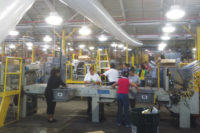In addition to the comfort factor, portable cooling directly impacts safety by reducing heat-related fatigue, illness and accidents. It can also improve productivity and help ensure more consistent manufacturing results by protecting workers and processes alike. Portable units can be moved around to different locations and easily installed to deliver spot cooling to the most demanding production areas.
It is also worth noting that portable need not be synonymous with temporary. Portable equipment is often installed on a permanent basis to cool areas with especially heavy heat loads, or to deliver supplemental cooling to growing facilities where the primary HVAC system is no longer adequate. Installed cost is often just a fraction the cost of conventional HVAC equipment.
There are three main categories of portable cooling equipment available:
- Air-cooled portable air conditioners work by pumping in cool air and exhausting hot air out through ductwork. Air-cooled portables are most often the system of choice because they can be installed almost anywhere, usually in minutes.
- ater-cooled portable air conditioners connect to an external water source. They are very efficient to operate but are best suited for use in facilities with central cooling towers or chiller systems, or in regions where the municipal water supply is plentiful and economical.
- Evaporative coolers use an internal or external water source to provide cooling and a fan to push the air across the space. Though their performance is not comparable to portable air conditioners, they deserve mention as a simple, economical cooling option — especially for areas where budget or power supply is limited. They should be positioned in an area where large amounts of outdoor air can be drawn in, e.g. near a loading dock door in a warehouse or manufacturing area.
Sizing and installation factors
Sizing of portable equipment should not be left to guesswork. A starting point is to plan on 3.413 BTU per watt when calculating equipment size. This starting point applies to a so-called “typical” space with no additional loads other than lighting. You then need to calculate additional heat loads based on windows or other openings, occupant level and activity, process equipment in the area and how much wattage it consumes and heat it generates, etc. If cooling is already coming in via a central air handling system or other source, this too should be factored in.
After installation, if sizing turns out to be less than perfect, all is not lost. Remember, a big advantage of portable cooling equipment is — to state the obvious — its portability. A rented unit can be readily swapped out with a larger or smaller model to ensure optimum performance.
Power supply: Every model of portable air conditioner is designed for use with a particular type of electric circuitry. So after you have sized the equipment and determined the required tonnage, the available power supply might dictate your final equipment selection. With recent technological advances, the choices are better than they were just a few years ago. There are now portables on the market that will run on convenient 460-volt 3-phase power and deliver an impressive 5 tons of cooling or more — allowing a single unit to do the job where two or three used to be needed.
Installation: For most industrial applications, you will want to locate the portable cooler inside the space and use a single duct coming off the top of the unit to dissipate hot air into the return air plenum or out of the space. If a spot cooling effect is desired, select a model equipped with cold air nozzles (sometimes called “snorkel packs”) that allow you to direct the air at hot spots within the room. If the portable cooler has a grill-front design, kits are available to retrofit most units with nozzles.
If the portable cooling must be located outside the room due to floor space limitations or other concerns, you will need to find a way to get the return and cold air supply in. This might involve cutting openings in the dry wall to insert the ductwork. If the portable installation is temporary, alternative solutions can usually be found.
Often a portable unit will be used to cool an office, conference room or other small space within a warehouse or manufacturing area. If it is a large facility with high ceilings, the hot air can usually be discharged up toward the ceiling with minimal effect on the rest of the building.
Condensate disposal: The cooling process creates condensate water, so you will need to dispose of this water — either using a condensate tank or bucket that comes with the portable cooler, or a condensate line that runs to an external drain.
More selection factors
Always look for a high-quality industrial grade portable cooler. The low-cost portables available from home improvement retailers do not have the cooling capacity or durability needed for heavy-duty applications. A reputable distributor should be able to lead you through the selection process and provide technical and installation assistance.
When selecting a supplier, ask what kind of technical support is available. Look for a supplier who carries different types of equipment from multiple manufacturers so you can get unbiased advice on your application. Ask what accessories are available and whether they are included in the basic rental price. If you work on government projects, determine if the distributor is GSA certified. Also make sure your supplier has locations convenient to your customers for rapid response when emergency cooling is needed.


